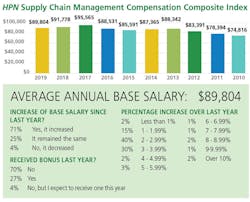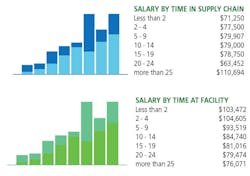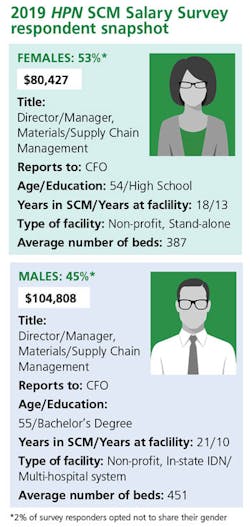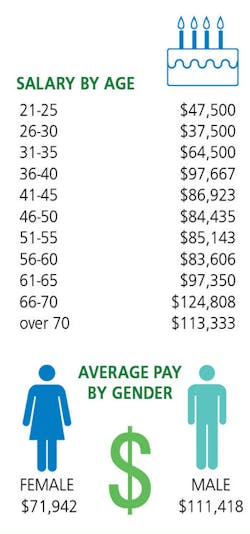Vertigo presses supply chain compensation levels
Special Focus
When industrial and trade activities slow to the point of a general decline in the gross domestic product (GDP) calculations for two consecutive quarters, economists will scurry from their ivory tower lairs and declare a recession.
When compensation for supply chain professionals dips for two consecutive years, those pros might polish their CVs, poke around online job sites and reach out to their contact lists.
Based on the results compiled from Healthcare Purchasing News’ 2019 Supply Chain Compensation Survey, the compensation composite index (based on the aggregate average salary of all survey respondents) slid 2.2 percent for the year to $89,804 from $91,778, almost the equivalent of the current rate of inflation (which is 1.9 percent as of December 2018).
While that sounds stark it may not be cause for panic yet. In fact, 92.6 percent of survey respondents said they feel somewhat to very secure in their positions, with 70.6 percent earning between a 2 percent to 4 percent salary increase (average 3.3 percent, relatively consistent with last year) and 87.3 percent of that group attributing their raise to job performance alone. Another 7 percent cited promotion with a change in responsibilities and 5.7 percent a change in responsibilities only.
Still, you don’t have to be Isaac Newtown, Ruby Johnson or Tyrone Davis to recognize that what goes up must come down.
Extending your view of HPN’s supply chain compensation composite index (CCI) back 10 years merely illustrates riding in a 1972 Ford Country Squire station wagon with rear shock absorbers that need replacing. Looking back, the end-to-end result of the bumpy ride puts the 2019 CCI 20 percent higher than the figure at the beginning of the decade in 2010.
Title ticker tape
Focusing on three key titles representing the largest pools of respondents, however, offers a clearer picture of compensation trends.
Among the largest segment of respondents, Directors and Managers of Materials Management/Supply Chain reported something of a fiscal shimmy during the last three years. The average annual salary for this group slipped a mere 0.3 percent in 2019 to $94,096 from $94,354 the year before, according to the survey.
The data in the previous two-year period represented a more positive mirror image with the $94,354 salary reported in 2018 coming in 0.4 percent higher than the $93,974 reported in 2017.
Purchasing Directors and Managers, however, reported a more dramatic shift during the three-year period. The 2019 figure of $76,484 is 2.5 percent below the previous year’s result of $78,421. But the 2018 result of $78,421 was 17.9 percent higher than the $77,045 result in 2017, the survey showed.
Senior Buyers, Buyers and Purchasing Agents represented the third-largest segment in HPN’s annual compensation survey and reflect one of the bright spots among the title segments of the survey’s response pool.
The average annual salary reported by Senior Buyers, Buyers and Purchasing Agents in 2019 increased 1.4 percent to $54,868 from $54,091 last year. This represents continued growth from the 2017 data, albeit with slowed momentum. That’s because the average salary for Senior Buyers, Buyers and Purchasing Agents in 2018 ($54,091) represented a 5.3 percent increase from the year-earlier period of $51,371, according to HPN survey data.
As a customary cautionary caveat, HPN advises readers that survey data and trending perspectives hinge on the number and mix of respondents by job title, facility type and location, and gender. For example, more senior-level executives who lead centralized integrated delivery network (IDN) operations generally will elevate salary data, while more buyers at community hospitals may push the salary data lower.
Supply chain veteran Dee Donatelli, Director, Value Analysis Consulting, TractManager Inc., and Principal, Dee Donatelli Consulting LLC, expresses “shock and disappointment” at the “low value” being placed on supply chain management in today’s industry.
“Over the past decade the annual base salary of supply chain professionals has only increased marginally in relationship to the expectations being placed upon the positions,” Donatelli noted. “As operating margins are challenged supply chain professionals are asked to decrease costs at a rate double that of revenue growth. The salaries represented here are less than the savings generated by supply chain in potentially one well-negotiated or implemented contract.”
Vance Moore, President, Business Integration, Mercy, furrows his brow, too.
“I was disappointed to see total compensation being reasonably flat for the last four or five years, even declining a little in the last three years,” Moore told HPN. “This could be due to younger leaders replacing more seasoned leaders that had a high base. That would correlate to the first finding of most leaders seeing an increase yet the total compensation falling slightly. Lower-cost leaders may be replacing higher-comped outbound leaders.”
Joe Colonna, Vice President, Supply Chain, Piedmont Healthcare, the 2018 Supply Chain Department of the Year, points to the titles themselves as a possible culprit.
“The challenge in aligning these salaries may be titles,” Colonna noted. “Our industry is far from standardized when it comes to titles.”
Donatelli contends that these survey data should serve as a clarion call to motivate the industry to action.
“The results of this survey validate the need for supply chain executives to promote their role, their contribution and their value within their own organizations,” Donatelli told HPN. “Unfortunately, as in most professions we must make career changes to advance our worth as well as our salaries. The tendency in supply chain is internal promotions and little movement from locations. It is not uncommon to learn that a supply chain director started on the receiving dock, became a buyer and has been in the institution for over 25 years. This results in diminished value, both of the role and of the marginal increase in compensation. This pattern is also having a negative impact on new young professionals. They are seeing that the path to advancement is slow and tedious and that the salaries are not sufficient in relation to the overall impact on the work being performed.”
Donatelli, who also serves as Chair-Elect of the Association for Healthcare Resource and Materials Management (AHRMM), reinforces investment in supply chain personnel on their contributions alone before the market forces the issue based on next-generation demands.
“An effective supply chain professional saves more than their salary in a single negotiation, yet seldom demonstrates this value to be recognized and accordingly compensated,” she said. “It would be suspected that when 50 percent of senior supply chain management [professionals] retire within the next five years, organizations will be forced to increase the salary base to attract talent to fill these roles. Individuals waiting for their managers to retire to be promoted need to be prepared to demand fair adjustments and compensation in salaries based upon contribution margins they provide to their organizations.”
Moore questions the longevity factor. “I was surprised to some degree to see that time in supply chain meant very little,” he said. “Unfortunately, this could indicate a lack of respect for the expertise that is gained over time. Another conclusion could be that new leaders demand a higher premium, potentially due to education or just market [forces]. Unfortunately, it is very easy for a good supply chain leader to be quietly doing their job and only be provided small increases every [year] without advanced progression, based on contribution. Tenured supply chain leaders need to tell their story better and if not rewarded, consider making a move to a new environment that will appreciate their contributions.”
Colonna concurs. “New team members are coming to organizations with a different set of expectations and more folks are coming from outside healthcare, which, in some cases pays better,” he added. “We are going to have to pay more for new, young talent. On the other hand, we should be able to expect more from that talent as well – more creative and strategic thinking.”
Moore hones in on the “salary by time at facility” statistic and posits a curious potential tren about tenure. “New leaders are making more than tenured leaders in the same facility,” he said. “This may indicate that leaders are being overlooked until they are gone, and then the facility has to pay market rate, which is higher than respecting the tenured leaders. There is not a huge spread in this category, but it clearly indicates that tenure is not respected.”
Regional revolving
Dividing the compensation composite index by region returns the overview to familiar refrains where the opposite coasts represent the most lucrative areas for earnings, according to survey results.
From the overall lower CCI this year, all five regional divisions posted declines from 2018 results. As part of its survey collection and analysis, HPN divides respondents into five geographic regions: Northeast, Southeast, Central, Mountain and Pacific.
The West Coast or Pacific region returned atop its perch as the most lucrative area for compensation where it settled for a decade, save for last year’s slip to the No. 2 spot. Meanwhile, the Southeast bumped up to the second slot after spending half the previous decade as No. 3. What’s noteworthy is that the composite for the Northeast region continued for the second consecutive year in the fifth and final spot, and that area pulled the largest number of survey respondents.
What’s noteworthy is how some of the key titles break down, which also may be affected by location, size and type of facility.
Directors and Managers of Materials Management/Supply Chain based in the Pacific region reported earning the highest amount at $116,591, followed by those in the Central region at $97,115. Directors and Managers in the Southeast region reported earning the least of the five regions at $83,625, according to the survey.
Purchasing Directors and Managers in the Central region reported earning the most at $85.500, followed closely by those in the Northeast at $85,455. Those in the Mountain region reported earning the least at $73,500, the survey showed.
Senior Buyers, Buyers and Purchasing Agents in the Pacific region led reported salaries at $61,500, followed by those in the Northeast at $57,222. Those in the Mountain region reported earning the lowest at $39,167.
Lacking genderosity
In fact, according to composite index breakdowns by region, compensation for men squarely resides within the six-digit range, while compensation for women barely exceeds the $75,000 on average. Regional composite compensation differences between the genders spans nearly $31,000 to $52,000 with the overall composite difference amounting to roughly $39,000.
That sobering statistic doesn’t sit too well with Donatelli.
“The significant discrepancy between women’s and men’s salaries in the same role is deplorable,” Donatelli detonated. “In 2019 this is inexcusable!
“This information should serve as motivation for all of us,” she continued. “We have a responsibility to promote our profession and demonstrate our contributions. The industry needs to be more proactive in sharing the significant impact supply chain makes on our organizations operating margins by reporting achievements. To attract the next generation of supply chain professionals we have a responsibility to advance our salaries by expanding our scope and roles within our institutions. Supply chain is not about moving boxes, stocking shelves and buying stuff off GPO contracts. Supply chain needs to promote itself as a high-functioning and critical success factor for facilities financial viability and sustainability.”
Overall, 52.6 percent of survey respondents identified themselves as female, according to the survey, compared to 45.2 percent who identified themselves as male. The remainder preferred not to respond to the gender specification question.
Most intriguing, even though the Pacific region posts the highest composite salary overall, the Southeast region posts the highest composite salaries individually for men and women as the number of respondents in the Southeast exceed those in the Pacific region.
Among the three key titles with the largest number of respondents surveyed, the compensation gap between the genders averaged about $25,000, according to survey results.
Male Directors and Managers of Materials Management/Supply Chain out-earned their female colleagues by more than 30 percent, or $24,243.
Male Purchasing Directors and Managers also exceeded their female colleagues by more than 38.1 percent, or $24,980.
Average compensation for men in the Senior Buyer, Buyer and Purchasing Agent positions outpaced their female colleagues by nearly 53 percent, or $25,764.
Educational edification
From the overall composite breakdowns to those by gender and by title, the trend remains consistent. The farther and higher you go in terms of your educational exposure and achievement the higher your compensation reaches. See the chart on page 11 with the details.
Directors and Managers of Materials Management/Supply Chain who earned a Bachelor’s degree reported earning $100,786, compared to $73,056 with an associate’s degree and $67,333 with a high school diploma. Any post-graduate degrees boosted compensation to $132,000 on average, according to the survey.
For Purchasing Directors and Managers, a Bachelor’s degree afforded them $78,056 on average, compared to $68,125 with an associate’s degree and $53,500 with a high school diploma, the survey showed.
Senior Buyers, Buyers and Purchasing Agents who earn a Bachelor’s degree reported earning $78,125, while those with an associate’s degree reported earning $49,643 and those with a high school diploma, $45,978.
Moore singles out education and experience as a key barometer.
“All in all, I think that education, title, and age are the key elements of compensation progression,” he said. “It appears that if you have a Bachelor’s degree and have proven yourself for 15 years and are stepping into a title of director or above, you are in the sweet spot. If you are not being appreciated with progressive compensation, you should move on to a new position because the likelihood of being appreciated is not proving to be a rewarding strategy.”
But Moore issues a caveat.
“Statistics can tell any story we want to hear [when] we isolate a single variable,” he continued. “Compensation is often complex and can completely appear illogical if an organization is using the supply chain to develop highly educated future leaders versus another location that is highly staffed with lower paid co-workers. The best thing to do is understand your specific market and to understand the scope of the work. Determine a reasonable range and if you are not being rewarded, be prepared to have a conversation with your leader to understand why you are out of market. Compensation is very important, but if you associate your personal value in what you make, you will most likely be disappointed frequently throughout your career. Find a job that you love, a supportive team, and an engaged supervisor, and not only will you be rewarded with joy, the money will come with performance.”
Demographic details
Nearly 73 percent of survey respondents (72.6 percent) said they work in non-profit facilities, 19.1 percent in for-profit facilities and 7 percent in government-owned facilities with 1.3 percent responding “none of the above.” In terms of facility location, 36.1 percent of respondents said they work in a rural setting, 34.8 percent in a suburban setting and 29.1 percent in an urban setting, which may serve as a factor in lowering compensation levels.
Breaking down the three key titles by facility location shows that urban facilities tend to pay the most, followed by suburban and then rural facilities.
Most noteworthy: Compensation for Directors and Managers of Materials Management/Supply Chain in urban and suburban facilities is about $6,000 apart. However, the compensation for Purchasing Directors and Managers in suburban and rural facilities only is about $2,000 apart. For this group the urban-suburban spread is about $29,600. The difference in compensation for Senior Buyers, Buyers and Purchasing Agents is rather evenly spread among the three location types, the survey showed.
More than 55 percent of survey respondents (55.7 percent) oversee supply chain management for a single hospital, according to the survey, while 15.2 percent (the next largest segment) said they manage supply chain operations for one or two additional hospitals. The average across all survey respondents is 2.6 additional hospitals.
Meanwhile, 49.1 percent of survey respondents conduct supply chain operations for more than 6 non-acute care facilities, including clinics, surgery centers and physician practices, the survey showed. The next largest group at 18.7 percent said they don’t handle any non-acute care facilities. The average across all survey respondents is 8.4 additional facilities.
For the fourth consecutive year, survey respondents generally worked in larger facilities with the average size being 426.3 licensed beds with a 69.9 percent occupancy rate, calculated to 298 occupied beds. Last year, the respondents hailed from facilities with 408.5 licensed beds with a 71.4 percent occupancy rate, calculated to 291.7 occupied beds.
Fifty-three percent earned no certifications, with the next largest group at 17.4 percent, reporting they earned the Certified Materials & Resources Professional (CMRP) certification from AHRMM.
The average composite respondent to HPN’s 2019 salary survey is 54.1 years of age (up from 53.4 last year), has spent 19.5 years on average in supply chain management (down from 20.3 years in 2018) and 11.6 years at his or her current facility (down ever-so-slightly from 11.8 years last year). Their departments include 16.9 employees on average (compared to 16.8 last year).
About the Author
Rick Dana Barlow
Senior Editor
Rick Dana Barlow is Senior Editor for Healthcare Purchasing News, an Endeavor Business Media publication. He can be reached at [email protected].










